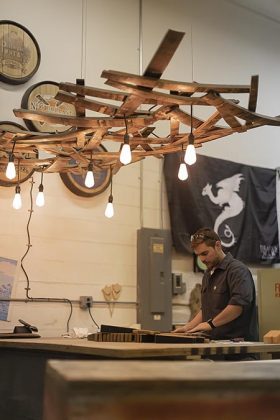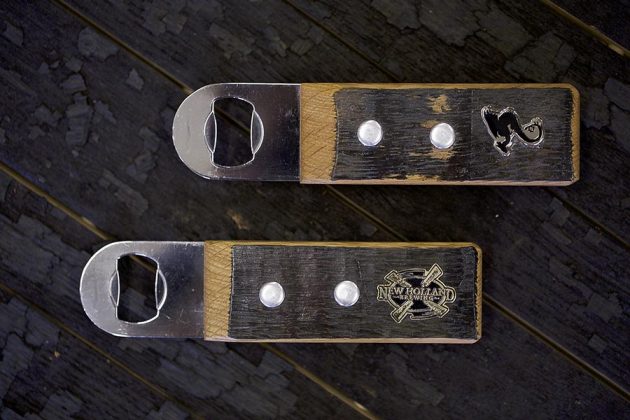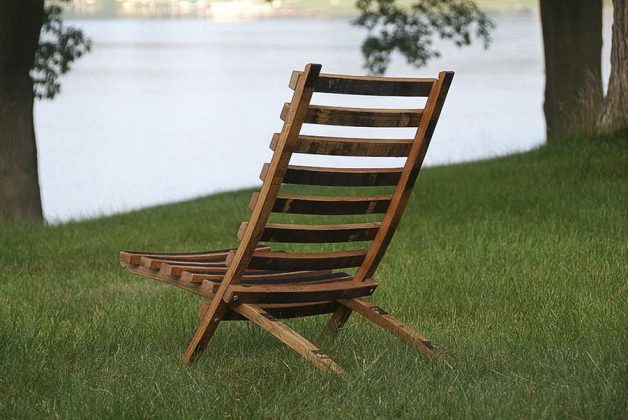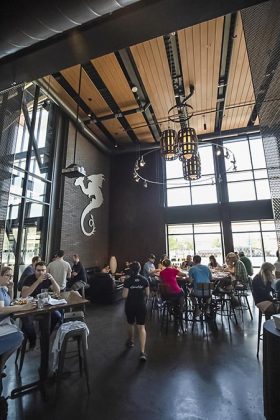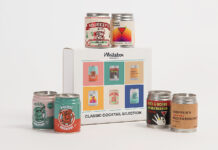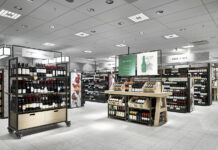The story of a whiskey barrel starts in a familiar place: In the cellars and warehouses of cooperages, where lengths of wooden staves are attach around circular barrelheads at each end before being banded together with metal, belt-like hoops called banding. For those with the good sense to store whiskey in them, you’ll generally find the insides charred with flames, so the flavor of the wood is more easily extracted by the spirit it eventually holds.
The barrel, as we know it today, was developed somewhere around 350 BCE by the Celts. It’s been around the block, so to say. It’s seen some things. But not everything.
Barrel-makers, or coopers, have a proud tradition of building immaculate vessels for aging whiskey or other spirits of choice, and many casks find themselves having two or three life cycles at a distillery before finally meeting the end of their usefulness from a spirit-making standpoint.
Unless it’s a barrel that is lucky enough to find its way into the distillery of New Holland Spirits in Michigan.
New Holland Brewery & Spirits started as a small brewpub in a semi-teetotaling town along Lake Michigan called, unironically, Holland, due to the large settlement of Dutch immigrants who made their home there. The brewery got its start in 1997, on the front end of the craft beer boom, and has long been one of the largest breweries in Michigan. The distilling came later, as founder and CEO Brett VanderKamp was looking to stretch his creative muscles.
By the time the distilling program laid down its first bottle of whiskey in 2005, New Holland was already well-known in the craft beer world for its barrel-aged stout, Dragon’s Milk. This whopper of a beer was brewed and then aged in bourbon barrels procured from a Kentucky distillery. It easily became the brewery’s biggest seller and has more recently picked up steam by partnering with Pabst as a distribution partner.
Even with early whiskey and bourbon being laid down, Dragon’s Milk was outpacing the amount of barrels the spirits arm could utilize in the early days of the program.
That’s when the distilling team got it in their heads to utilize the spent Dragon’s Milk barrels to house bourbon, allowing the brown spirit to soak up the rich beer flavor from Dragon’s Milk.
“As a company, we’re resourceful by nature,” said head distiller Brad Kamphuis. “You are inspired by what’s around you — and what was all around us, were barrels.”
After 90 days of bourbon sitting in Dragon’s Milk casks, Beer Barrel Bourbon comes out and goes into the bottle. From there the barrels go back to the brewhouse for Dragon’s Milk to take another pass at soaking up more bourbon flavor before it gets bottled up for its beer lovers.
The team figured out how to extend the barrel’s life. But was there more to be done?
“They just kept piling up,” said Kamphuis. “We might sell some off to homebrewers or distillers, but still, at the volume we were going through barrels, we were overrun.”
Enter an unlikely pair of heroes who rescued these barrels from an untimely fate.
Steve Raad, also known as Coop (short for Cooper) for reasons that will quickly become apparent, was hired at New Holland to help the long-serving catch-all maintenance guy, Jeff “Padre” Dyke. Whether or not there was an official title for Coop or the department itself is hard to determine. They were often tasked with unlikely jobs that would include random requests from the pub, the warehouse or even the main office. The influx of barrels found their way into the pair’s workshop, which was a little annoying, but ultimately fortuitous.
Coop, a graduate of Kendall College of Art & Design through Ferris State University, had found himself less in the traditional art studio during college and more on the basement level where steel and timber were the media of choice. The son of a woodworker, Coop felt most at home in the metal and wood shops working on sculpture and functional art pieces.
It was during a New Holland staff Secret Santa gift exchange that resourcefulness once again came into play.
Surrounded by barrels and occasionally the scraps that accompanied them, Coop picked up a barrel stave and fashioned together a bottle opener, which found its way onto his Secret Santa recipient’s desk. While Coop had almost assuredly blown his cover as the gift giver, his bottle opener quickly became coveted by all the staff and requests for Coop to make more came in quickly.
Padre saw the creative spark in his young coworker and gave Coop a random assignment.
“Padre was like, why don’t you make something with all this scrap?” Coop remembers. “That was all I needed. I was off.”
Inspired again by what was around him, wood and the mighty Lake Michigan, Coop created a beach chair made from barrel staves that had collected around the shop. At a weekly “dorm meeting” where drinks and story swapping are the key components, Coop showed the chair to VanderKamp. New Holland’s founder has a passion for art and began jamming on ideas with Coop and Padre. The chair, a nearly all-wooden, detachable and totally travel-sized miracle, was created and later patented.
“It felt good to use those two sides of myself,” explains Coop, “the imagination and the woodworking.”
It only takes sales folks a hot second to catch a whiff of something cool, and soon requests started pouring into the small workshop: more bottle openers for customers, which led to barrelhead signs and product displays for bars, bottle shops and other retail spots. Later came exquisite, branded tap handles for Dragon’s Milk. Almost a returning home. The BarrelWorks Project, as the studio became known, was official.
Little by little, additional requests came in for the woodworking duo: some unique gifts for corporate anniversaries, others for distributors and clients. Soon there were coat hooks, guitar stands, clocks and even a barrel stave belt buckle. They started selling online and in the pub’s retail store.
“At first, we definitely weren’t making money for the company,” said Coop. “But there was always the sense that we were adding value.”
It was an expansion from small town Holland into the newly-minted Beer City, USA of Grand Rapids, MI, where Coop would see just how far BarrelWorks could add value.
It was the first big move they’d made to grow from a physical sense and New Holland wanted Beer City to take them seriously and for patrons to know exactly who they were when they walked in the door: a company rooted in craftmanship and artistry.
“Grand Rapids became a blueprint of how New Holland wanted not just to represent ourselves,” said brand manager Adam Dickerson, “but how we wanted to interact with our customers.”
As you walk into The Knickerbocker, named after New Holland’s gin and the moniker given to Dutch settlers in New York who rolled their knickers just below the knee, you can’t help but marvel a bit at the space. With two-story high tin ceilings, handmade wooden benches in the waiting area, barrel stave wainscoting and giant artistic wonders hanging over your head, doubling as lighting fixtures. The man at the center of many of those designs? You guessed it: Coop.
“As we are working on a new project, we’ll get together with the architect and talk about what’s needed,” said Coop. “I’ll walk away with a list to creating shelving, sometimes a bar. We’re even looking at making our own tables for our current project.”
To date, the little BarrelWorks Project has outfitted not only the multistory brewpub, cocktail lounge and beer garden in Grand Rapids, but given the Holland pub a visual refresh using some of the same barrel stave wainscoting and wooden features. Additionally, newer projects like their tasting room in the quaint lakeside town of Saugatuck was equally draped in pieces crafted in Coop’s workshop.
“Staves aren’t perfect and precise in their shape and size. They have this unique writing, stamps and branding on them,” said Coop. “It’s not like starting a project with cut lumber; you have to figure out the design as you go. That’s what makes it so fun and also so interesting to interact with.”
New Holland recently took over an old space in downtown Battle Creek, Michigan, looking to turn it into its next microbrewery and distillery. As demolition ensues, Coop is getting his hands on 100-year-old flooring from what was once a J.C. Penney department store and is dreaming up what he’ll make from it. Waste isn’t a part of New Holland’s vocabulary, so Coop carefully considers what he’ll do with each plank, just as he does with each stave, barrelhead and length of banding.
“Even the wood chips that are left over are used,” said Coop. “Employees take them home for their fireplaces and outdoor fire pits. It’s about as close to zero waste as you can get.”
Even with an eye on zero waste, it begs the question, why put money, resources and salaries into what others might deem a pet project, particularly with that strong Dutch frugality?
“Not to sound like the ‘company man,’ but our mission at New Holland is to enhance our customer’s quality of life by providing remarkable experiences,” said Kamphuis. “And that’s what we do with these barrels. Coop and the team are improving a person’s experience by giving them these beautiful and artful spaces to enjoy a beverage and time with the people in their lives. That’s why we do anything we do.”
Eight years into the BarrelWorks Project, Coop returns to his slightly larger workshop these days, now with a new partner, Ed Greiner, who works steadily nearby. Coop leans over his worktable, under the unique lighting fixture he’s created for himself. The ideas pop up overhead like the dangling bulbs lighting his work station. He’s drawing and dreaming up what’s next. Somewhere in the sketches is a new project inspired by the disassembled barrels now neatly and reverently stored in racks. It will pay tribute to the contribution of each cask that passed through the distillery and brewery and ultimately become something altogether new, something that honors the art of the craft.

